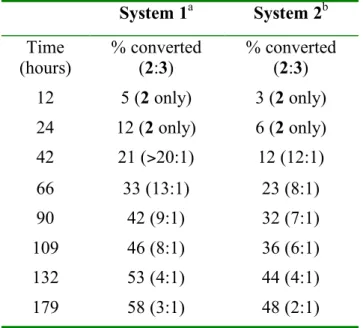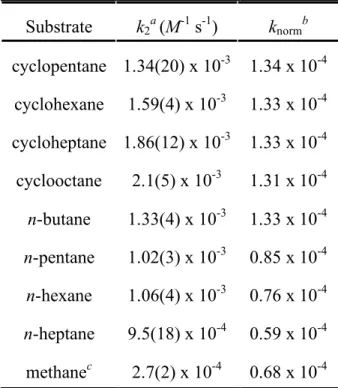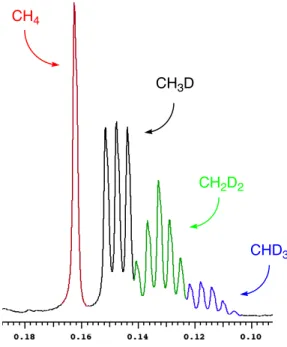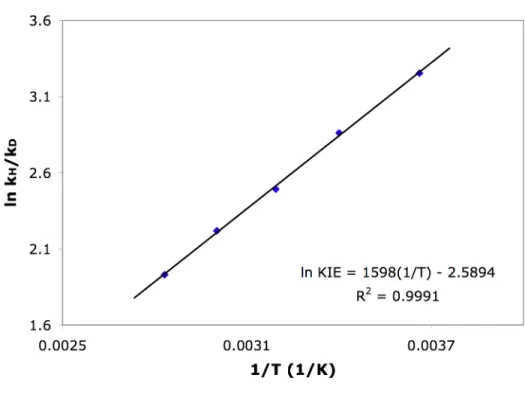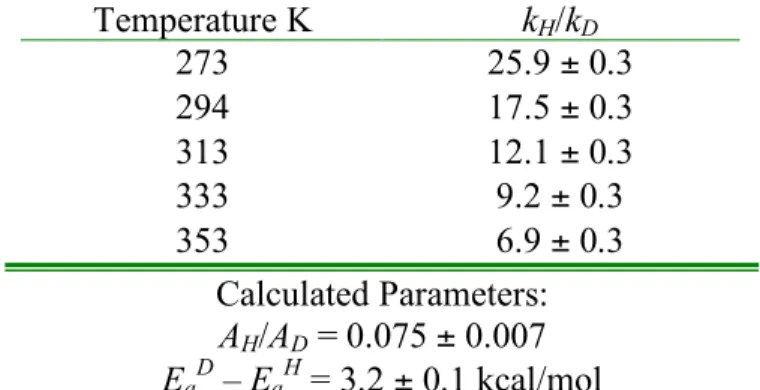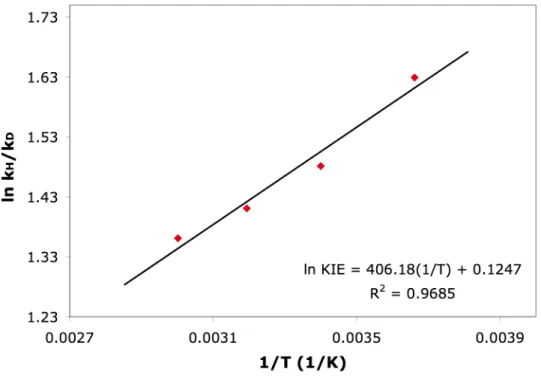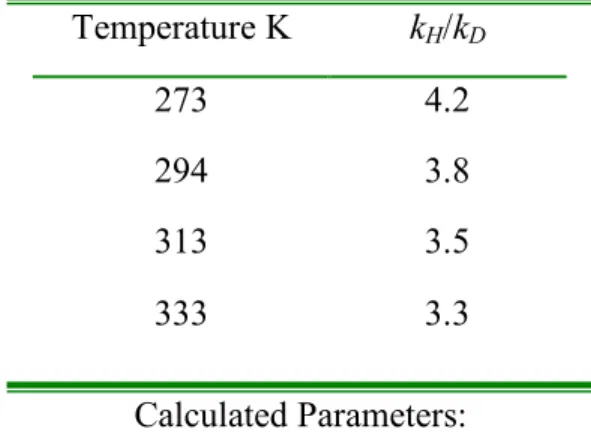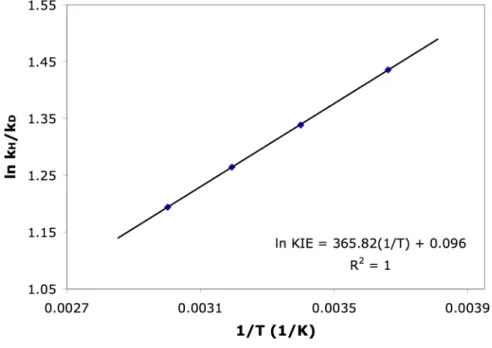Experimental results showed that protonolysis of (COD)PtII(CH3)2 (COD = 1.5 – cyclooctadiene) with trifluoroacetic acid gave abnormally large (greater than 10) kinetic isotope effects (kH/kD) at room temperature and higher. The temperature dependence of kH/kD for the protonolysis of (COD)PtII(CH3)2 gave Arrhenius parameters outside semi-classical limits. On the other hand, protonolysis of (tmeda)PtII(CH3)Cl (tmeda = N,N,N',N'-tetramethylethylenediamine) with trifluoroacetic acid gave normal kinetic isotope effects and classical Arrhenius parameters.
Density functional theory (DFT) was used to investigate the mechanism of protonolysis of these two. Based on our experimental and computational work, we propose that protonolysis of methylplatinium(II) complexes can occur through either a concerted or stepwise pathway that is highly ligand dependent; more electron-rich ligands will favor the stepwise mechanism, while electron-deficient ligands with stronger trans influence will favor the concerted mechanism.
General Introduction
Although alkane oxidations at high temperatures and pressures are well known, these reactions often proceed through free radicals, making it difficult to achieve both high conversion and partial oxidation selectivity.3 In contrast, homogeneous low-temperature activations of C-H bonds do not need, and often do not involve, radicals and can lead to more selective reactions than those promoted by heterogeneous catalysts operating at high temps. For example, [(2,2'-bipyrimidine)PtIICl2] catalyzes the selective oxidation of methane in fuming sulfuric acid to give methyl bisulfate in 72% one-pass yield at 81% selectivity based on methane.6 It has also been demonstrated that with a proper cocatalyst (CuCl2) at elevated temperature, the Shilov chemistry can be made catalytic with dioxygen as the terminal oxidant.7 In addition to platinum, palladium salts can also oxidize methane to methanol derivatives in strongly acidic solvents such as trifluoroacetic acid.8 By combining three redox couples (Pd( II)/Pd(0), quinone/hydroquinone, NO2/NO), one-pot catalytic oxidation of methane selectively to methanol using dioxygen in CF3COOH at a temperature as low as 80 °C can be achieved.9 Although there have been great progress, the development of practical catalysts to convert alkanes into value-added products with milder conditions and higher catalytic turnover rates is an ongoing challenge. The CH activation step (i) controls the overall rate as well as the selectivity of the catalytic cycle shown in Scheme 2.
Unfortunately, direct detailed study of the mechanism of this step is difficult in the "real" Shilov system due to its complexity and interfering side reactions. In Chapters 3 and 4 we will study the microscopic reverse of the C–H activation step by protonolysis of two different alkylplatinum(II) model systems: (COD)PtII(CH3)2.
Investigating the Mechanism of Alkane C–H Activation with Cationic
Both linear and cyclic alkanes give the corresponding alkene-hydride cation [(N-N)PtII(H)(alkene)]+ via (a) rate-determining coordination of the alkane to form a C-H σ complex, (b) oxidative cleavage of coordinated C-H bond to give a platinum(IV) alkyl-methyl-hydride intermediate, (c) reductive coupling to generate a σ-methane complex, (d) methane dissociation, and (e) β-H elimination to form observed product. The statistical mixing of the five Pt-methyl hydrogens and the coordinated methylene unit, via fast, reversible steps (b) and (c), and the exchange of shared C-H bonds of methane and cyclohexane C-H σ adducts, has been observed before methane loss. We report here on an investigation of the rate and selectivity of C-H bond activation for various linear and cyclic alkanes with this model system.
The kinetics of the reactions of the other cyclic alkanes (cyclopentane, cycloheptane and cyclooctane) with 2-d0.43 showed similar behavior (background decomposition rates were somewhat higher) releasing CH3D and CH4 in ~1:2 ratio, with second-order rate constants k x 10-3 M-1 s-1 and 1.86(12) x 10-3 M-1 s-1 for cyclopentane and cycloheptane, respectively. We therefore conclude that the products of the reaction of n-pentane with 2-d0.43 are the E and Z internal olefin adducts (7-E and 7-Z) formed in a 2:1 ratio (Scheme 6).
![Figure 1. Plot of k obs versus [hydrocarbon] for C 6 H 12 ( ♦ ) and C 6 D 12 () at 40 ° C](https://thumb-ap.123doks.com/thumbv2/123dok/10406733.0/28.918.220.756.702.1065/figure-plot-obs-versus-hydrocarbon-c-h-12.webp)
Investigating the Temperature Dependence of the Primary Kinetic
Protonolysis of (COD)PtII(CH3)2 by trifluoroacetic acid gave abnormally large kinetic isotope effects (KIEs) as well as Arrhenius parameters falling outside semi-classical limits. Protonolysis of (COD)PtII(CH3)2 1 with two equivalents of B(C6F5)3 in anhydrous TFE-d3 at room temperature (COD = 1,5- cyclooctadiene) generates neat [(COD)PtIICH3(OCD2CF3)]+ 2 and methane. Furthermore, no platinum(IV) hydride intermediates are detected by 1H NMR in the protonolysis of 1 in CD2Cl2 at -80 °C.
Temperature dependence of kH/kD in the protonolysis of 1 by TFA (determined from the average of 3 runs at each temperature). In sharp contrast to 1, the KIEs measured for the protonolysis of 4 are much less temperature dependent. Temperature dependence of kH/kD in the protonolysis of 4 by TFA (determined from the average of 3 runs at each temperature).
The temperature dependence of kH/kD in the protonolysis of 1 and 4 suggests that a correlation exists between the mechanisms and the measured KIEs. In summary, we found that the electronic nature of the ligand can have a large effect on the temperature dependence of kH/kD in the protonolysis of methylplatinum(II) complexes. Protonolysis of (COD)PtII(CH3)2 by TFA gave anomalously large KIEs at room temperature and above, as well as Arrhenius parameters falling outside semi-classical limits.
Further theoretical studies on the protonolysis of methylplatinum(II) complexes will be discussed in the next chapter. An analogous procedure was used for the protonolysis of 1 in CD2Cl2 at room temp. A procedure analogous to 1 was used for the protonolysis of 4. The average CH3D/CH4 ratios of three runs at each temperature were used.
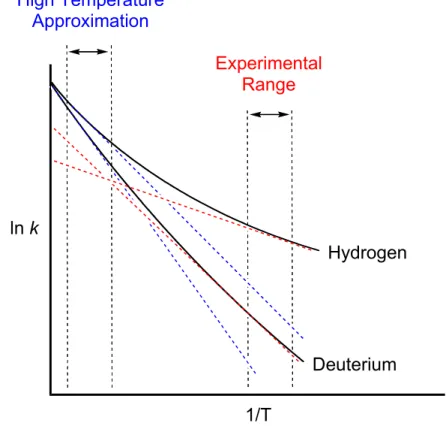
Computational Studies on the Protonolysis of Platinum(II) Methyl
The protonolysis of (tmeda)PtII(CH3)Cl and (COD)PtII(CH3)2 by trifluoroacetic acid was studied using density functional theory (TFA). Protonolysis of (tmeda)PtII(CH3)Cl appeared to occur via a stepwise mechanism, while for (COD)PtII(CH3)2 a coordinated pathway appeared to be preferred. A transition state, TS1a, was located prior to the formation of the Pt(II)-methane σ-adduct 7 for the coordinated pathway.
A potential energy surface scan for the reverse process shows that the energy (in 1,2-dichloroethane) decreases monotonically as the platinum hydrogen distance increases (Figure 1). This result suggests that reductive elimination is the rate-determining step of the stepwise pathway. Calculated KIEs for the protonolysis of (tmeda)PtII(CH3)Cl with trifluoroacetic acid in DCE.
By vibrational frequency analysis of the optimized complexes, we calculated KIEs for the protonolysis of 3 by TFA at different temperatures without tunneling corrections ( Table 1 ). Similar to the protonolysis of 3, no intermediate from 2 to the Pt(II)-methane σ-adduct 10 could be located for the concerted pathway, while a Pt(IV)-H intermediate 11 was found for the stepwise mechanism (Scheme 6) . Interestingly, the activation energy for the stepwise mechanism in the protonolysis of 2 (32.5 kcal/mol) is about ~ 3 kcal/mol higher than the activation energy for the stepwise mechanism corresponding to.
For the protonolysis of 2, the barrier for the concerted pathway is calculated to be 5.6 kcal/mol lower than the stepwise pathway, in contrast to the computational results obtained for 3 (combined pathway is slightly higher in energy than the stepwise pathway). Therefore, calculation predicts the protonation of the PtII-C bond as the rate-determining step for the protonolysis of 2 by TFA. Our calculation results indicate that the activation barrier for the protonolysis of 3 is (29.0 kcal/mol).
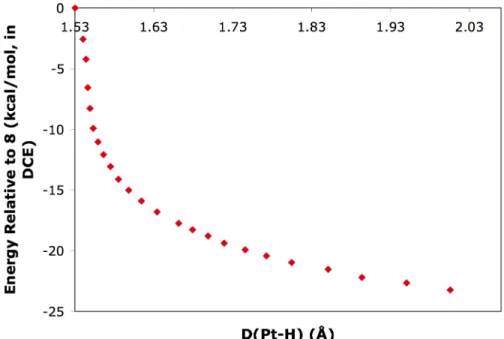
In aqueous solution, [PtII(glycinato)Cl2]- catalyzes oxidation by [PtIVCl6]2- of the methyl group of p-toluenesulfonate to the corresponding alcohol and aldehyde, with no further oxidation to the carboxylic acid. Both rate and selectivity were improved compared to the original Shilov system using [PtIICln(H2O)4-n]2-n as the catalyst. Over the past few decades, a number of examples of C–H bond activation by transition metal complexes have appeared in the literature.1 The Shilov system, an aqueous solution of [PtIICl4]2 and [PtIVCl6]2 salts that oxidizes alkanes to alcohols (and alkyl chlorides),2 have attracted much attention since its original discovery.3 Despite several attractive features, the Shilov system is impractical due to low reaction rates, expensive oxidant, and catalyst instability.
The original Shilov system oxidizes 1 at the methyl position to a mixture of the corresponding alcohol 2 and aldehyde 3 (Scheme 1); further oxidation to carboxylic acid 4 was not observed.5a The selectivity for 2 versus 3 decreases from ~ 10:1 early in the reaction (~ 10% conversion) to ~ 2:1 at ~ 45% conversion. Oxidation at the aromatic ring positions does not occur and the reaction remains visibly homogeneous for most of the reaction time, although platinum metal deposition is eventually observed after long periods of heating. By comparison, both conversion and selectivity are reduced by addition of bipyridine to the Shilov system (39 hours, 13% conversion, 5:1 selectivity for 2 over 3).5b In all three cases there was no overoxidation to the carboxylic acid 4, nor platinum metal precipitation is observed and no more than trace amounts of any other product are detected by 1H NMR.
The improvements in selectivity and rate with 5 as catalyst are remarkable, especially considering that PtIICl42- is generated from PtIVCl62- so that the solution increasingly contains the components of the original Shilov system. In both cases, platinum metal formation is only visible at the end of the long heating period. No reaction is observed when colloidal platinum is heated with 1, and activity is still observed in the presence of elemental mercury (a standard test for heterogeneous activity11); there is some decrease in activity but this may be because Hg0 is known to reduce both PtII and PtIV.5b. When 2 was prepared independently and subjected to the same conditions, the rate of formation of 3 was found to be somewhat slower using 5 as catalyst than with the original Shilov system,12 but the data do not rule out suppression of Pt0 formation by the glycinate ligand contributing to the increased selectivity.
Water (25 mL) was added, and the reaction mixture was heated to 100 °C with an oil bath. After heating for 10 minutes, 1 equivalent of KOH (0.135g in 20 ml water) was added dropwise to the reaction mixture over the course of 10 minutes. The reaction mixture was allowed to cool to room temperature, and the solvent was removed under vacuum to give a yellow residue.
While studying the protonolysis of (COD)PtII(CH3)2 with B(C6F5)3 in anhydrous TFE-d3, it was discovered that if a large excess of B(C6F5)3 was used, crystals would form overnight in the reaction flask. Analogous to (COD)PtII(CH3)2, protonolysis of (dmpe)PtII(CH3)2 with a large excess of B(C6F5)3 in anhydrous TFE-d3 led to the formation of crystals in the reaction flask.
